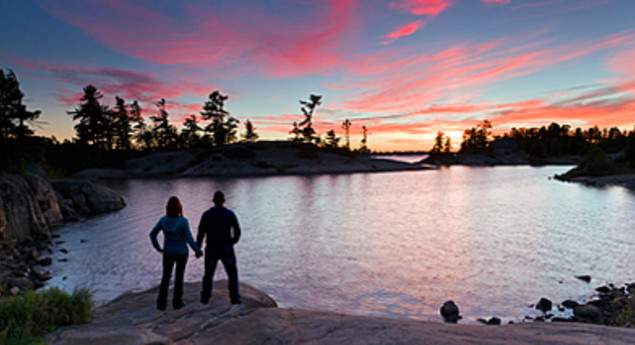The Georgian Bay Biosphere Reserve comprises the largest island archipelago of the North American Great Lakes. Known locally as ‘The Thirty Thousand Islands’, it consists of a complex association of bays, inlets, sounds, islands and shoals lying along the edge of the Canadian Shield bedrock, whose low lying hills and ridges characterize the adjacent mainland. This topography supports a rich mosaic of forests, wetlands and rocky habitat types with associated biodiversity. It is also noted for its extraordinary scenic views which attract large numbers of summer residents, cruising boaters and seasonal visitors.
The eastern coast of Georgian Bay has a complex topography with an extensive shoreline, along which are found numerous islands, deep coves, fiords and river mouths. It is thought to be the world’s largest freshwater archipelago comprising a mix of open waters, sheltered bays, coastal wetlands, exposed bedrock shores, sandy and cobble beaches, riparian vegetation and upland Boreal Needle leaf forests on the mainland. Characteristic tree species of the region include white spruce (Picea glauca), eastern white pine (Pinus strobus), white cedar (Thuja occidentalis) and red oak (Quercus rubra).
The rich mosaic of interconnected habitats, combined with the inaccessibility of much of the area, serves to support and protect a high level of biodiversity. The reserve hosts over 100 species of animals and plants considered to be species at risk in Canada. These include reptiles such as the eastern massasauga rattlesnake (Sistrurus c. catenatus), eastern fox snake (Elaphegloydii) and spotted turtle (Clemmys guttata).
Larger or more wide-ranging mammals found in the area include moose (Alces alces), black bear (Ursus americanus), river otter (Lutra Canadensis), marten (Martes americanus) and snowshoe hare (Lepus americanus).
he economic base of the Georgian Bay is centred on summer tourism, retailing services, small businesses and agriculture.
Most of the native aboriginal people living in the area are descendants of Ojibway, Chippewa, Odawa and Pottawatomi groups, who are united by a common language, kinship and clan memberships. A small number of Huron and Mohawk people reside in the area and have historical links with Iroquoian kinship groups to the south.
http://www.visitgeorgianbay.com/index.cfm
Earn 10 points!
Photo: http://www.pc.gc.ca/eng/pn-np/on/georg/index.aspx










